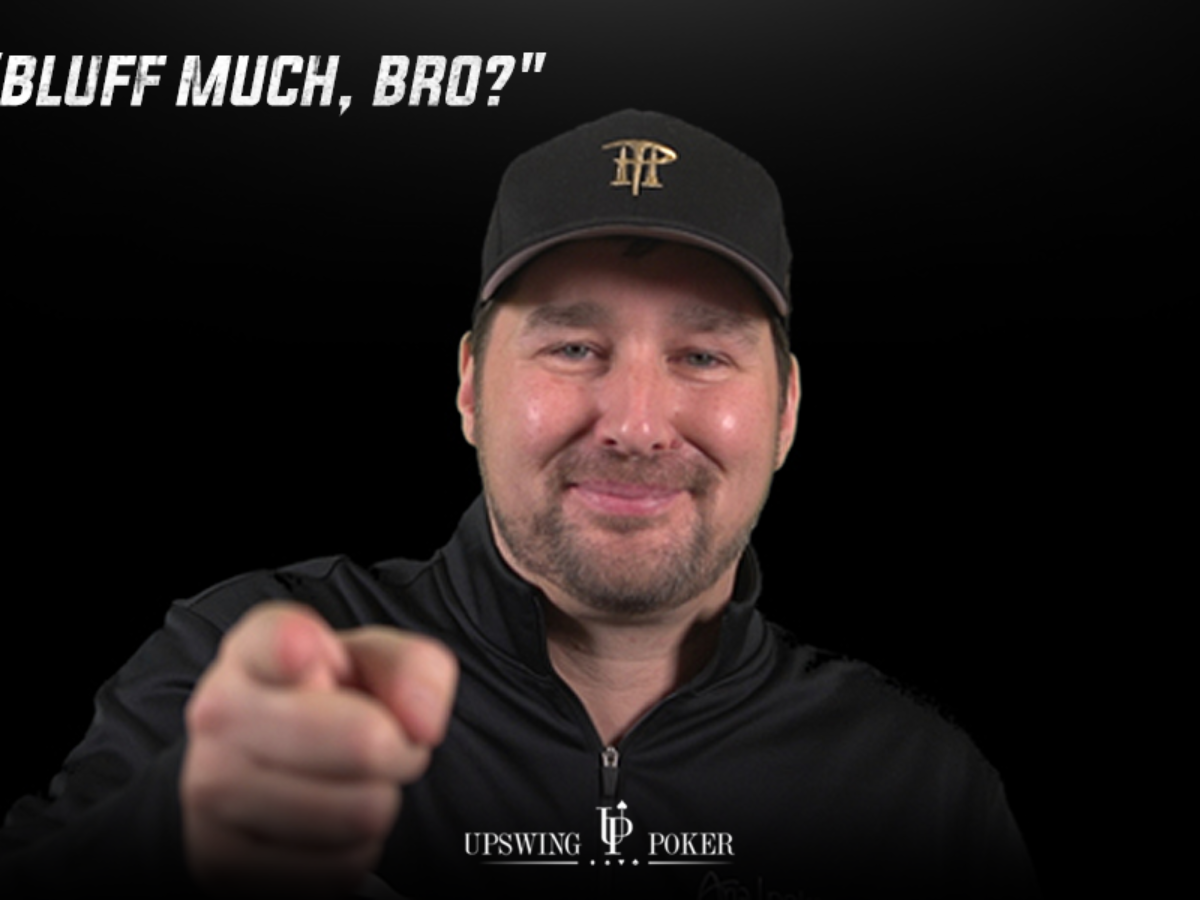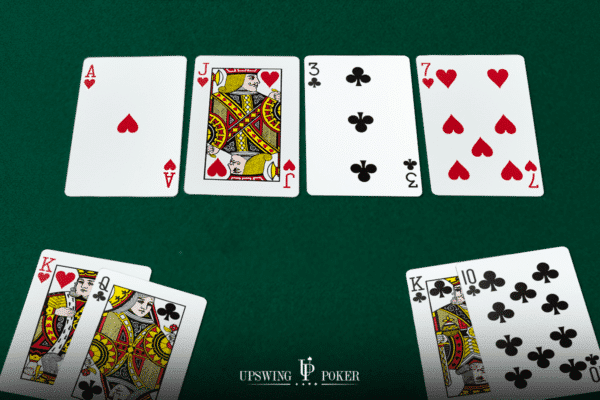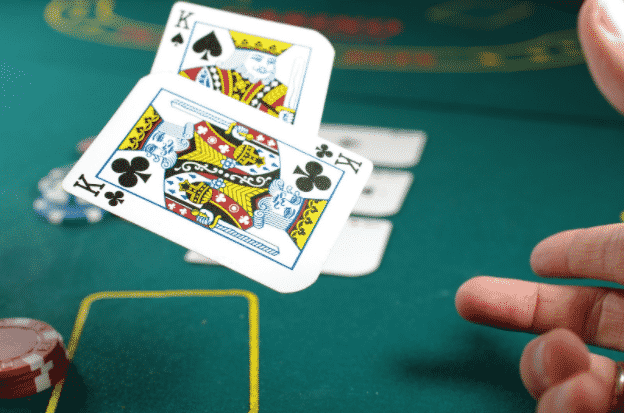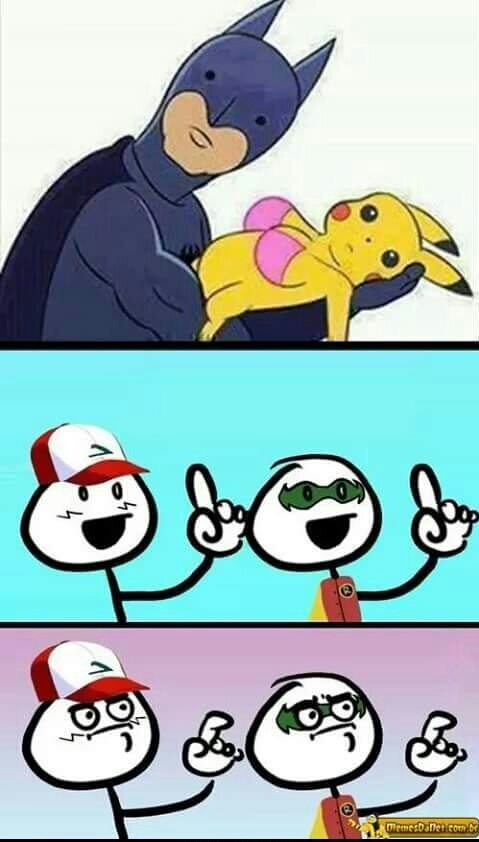Best Poker Bluffer
- Bluffing in poker is a risky strategy that can pay off in a satisfying way. Beginning poker players often think bluffing should happen often, but it's best to be selective about when you bluff. Practice bluffing when the stakes are low to build your skill in convincing opponents that you have a good hand.
- In 2014, I won my first World Series of Poker Bracelet, followed up with a 2nd bracelet in 2016. My online winnings are over $2,000,000 on Full Tilt and PokerStars alone, mostly at Heads Up No Limit, and those graphs are publicly available on HighStakesDB.
- HOW TO BLUFF IN POKER Bluffing requires you to be an aggressive player, and usually it’s the aggressive players that are winning players. (This is because they can win pots in one of two ways: (1) They have the best hand at showdown, or (2) everyone else folds to their bet or raise and they pick up the pot uncontested.). That said, it’s not about using blind aggression, but rather that.
- The understanding and awareness of certain factors are very important in poker bluffing. Some of which are the types of poker players at the table, the number of the opponents on the table, the ability of the bluffer to read the plays of his opponents, the cards on the board post-flop, the image already created by the bluffer for himself at the table, the size of the pot already on the table.
HOW TO SPOT A POKER BLUFF. To make the best possible decisions, poker players must notice and assess all information available to them, which includes picking up on tells from their opponents. Such tells can be verbal or physical (i.e. Body movements or positions that reveal the strength of one’s hand), or relating to the hand itself (i.e. Bet sizing and timing tells).

Australians lose more money gambling than people from any other country in the world.
In fact, our gambling losses are almost out of this world.
The average per capita loss works out at around $1200 each and every year. This figure, according to the same source, is twice as high as that of the United States! Scary, right?
As one of Australia’s most popular games, it’s safe to assume that we’re losing considerable sums playing poker. With hard-earned money on the table, improving our standard of play is of paramount importance to minimizing losses!
And recognizing poker tells is one way to do it.
After all, to spot someone’s tell is to know when they’re bluffing. Call their bluff and you’re more likely to a) win the pot, and b) keep your cash.
Love to gamble but hate losing money? Read on to discover the primary tells that’ll help you spot a bluffer in no time.
Your Invitation to the Best Online Pokies in Australia
Like a punt on the slot machines?
Our top rated slots for October 2019 are the smash-hit online pokie sites: Ruby Fortune and Jackpot City Casino.
These sites include some impressive matched bonuses – up to $750 and $1600 respectively! With the potential for some seriously big wins, here’s your chance to get a piece of the action:
What Is a Poker Tell?

First, though, let’s run through a quick definition.
To spot a tell, you first need to know what it is that you’re looking for!
For anybody new to the game, poker tells are perceivable clues that indicate the strength of a player’s hand. They might be physical or verbal in nature, and they’re of enormous help in winning a hand and/or keeping your money.
People (including you!) rarely know they’re doing them. As such, they’re almost always subtle in nature. Spotting a tell requires a keen eye and ongoing vigilance throughout a game.
You’re looking for any patterns in speech or body language that reveal somebody’s hand. Of course, you’ll never know exactly what they’re holding.
You may, however, be able to ascertain whether their hand is better or worse than your own.
This vital information can help you better judge your strategy in any given hand. You can raise, check, or fold in line with your assertions.
6 Common Poker Tells
With that all said and done, let’s turn to some common tells to keep an eye on.
The world of poker is full of possible tells; each person at a table is likely to have one or two that are unique to them! The ones you’re about to learn about, though, are more prevalent in nature.
Here they are:
1. They Avert or Hold Their Gaze
Next time you’re at the table, try staring your opponents dead in the eye.
People who meet your gaze with ease and confidence often have a quality hand. After all, they feel comfortable in their position of strength, which comes over in their demeanour.
In the same way, somebody who averts their gaze might be faced with a bad hand and/or be bluffing. Their position of weakness comes over in their body language, making them more inclined to look away.
Of course, that shyness could be a bluff as well! They could be pretending, in the hope of covering up a quality hand.
Remember that you’re looking for patterns.
Best Poker Bluffer Poker
Take note of a player’s hands each time they hold or avert their gaze. In time, you’ll start to register what, if anything, it indicates.
Another noteworthy point is that the actions should be distinct from their typical approach.
Someone might make a habit of looking at you dead in the eye. Rather than indicating a quality hand, it’s just the way they play!
2. The Timing’s All Off
This particular tell is ubiquitous in the poker world.
It’s one of the most common you’ll come across–especially in people new to the game.
These tells of timing are simple, yet, on occasion, hugely revealing. Basically, the time it takes someone to make their decision can vary according to the strength of their hand.
Let’s face it, if you’re going to fold, then you’re going to fold. In the same way, it can take longer to make a decision when you have a hand of any merit. Players who delay are often weighing up whether to check, match, or raise.
Overall, it pays to keep an eye on the time it takes someone to make a move. There are always exceptions, but swift decisions generally imply weakness; slowness is indicative of deliberation and strength.
Speed is often seen as a sign of confidence.
Thus, somebody plays fast and assuredly in an attempt to intimidate and opponent. More often than not, though, it’s merely a bluff–and an obvious one at that.
3. They’ve Got Shaky Hands
A player’s hands can hold numerous clues to their actual hand!
One of the most common tells of this nature is the occurrence of what are called ‘shaky hands’.
Think about what happens when you’re nervous or excited. Your heart rate elevates, you start to sweat, and, often you’ll notice your hands start to shake, right?
The same thing can happen in poker.
Newbies to the game will find their hands literally start to tremble upon holding and looking at their cards! It’s a sure-fire sign that something’s going on for other people at the table.
Furthermore, a cardinal rule of poker as that your hands should be above the table at all times (to stop you cheating). As such, this particular tell is exceptionally hard to hide! Try as you might, you can’t get your hands to stop trembling.
Somebody new to poker who’s displaying shaky hands is usually telling of quality cards. They’re excited about a potential victory and determined not to show it; their hands tremble as a result.
Best Poker Bluff
4. Their Chips Are Down
Here’s a second ‘hand-related’ potential tell.
This time, though, it’s to do with the stacks of chips on the table and how someone interacts with them. Basically, people with strong hands become over-eager to play!
Expecting victory, they’ll be ready and waiting, chips in hand, ready to place their bet. It’s like they can’t wait to play! They could be holding or playing with their chips well before it’s their turn.
In contrast, someone with a weak hand could care less and seem more passive as a result. Their hands, more often than not, will be away from their chips.
Remember that patterns of play are important for discovering someone’s tell.
Only upon noticing a particular pattern can you ascertain someone’s next move with any level of reliability.
5. Their Style Is Conservative in Nature
We’re taught from a young age not to judge a book by its cover.
But we can’t help it. We’re naturally judgmental, forming solid first-impressions of somebody with just 7 seconds of meeting them. And, in the world of poker, that rapid judgment can come in handy.

Essentially, you can tell a lot about someone’s style of play by the clothes on their back.
Players with a conservative dress sense are most often conservative players. That suit and tie might look smart at the office, but it’s revealing at the table.
That’s a major generalization, of course, but you’d be surprised at how accurate it can be. Stereotypes emerge for good reason, after all. Always watch out for someone’s dress-sense, and see how it corresponds with their tendencies at poker.
6. Their Face Tells a Picture
Our bodies are often our own worst enemy as poker players.
It can have a mind of its own, revealing crucial information without our permission. As an aside, strive to work out your own body’s susceptibilities.
By figuring out your own tell(s) you can:
- Work hard to stop them from showing
- Gain further clues as to other players and their hands
For example, imagine discovering that you go red in the face with a strong set of cards. Seeing someone else at the table get red-faced could indicate that they have a good hand.
The key is realizing that tells commonly come in the form of subtle (or obvious) physical responses.
A few further examples you’ll come across for a strong hand include a full smile, relaxed posture, wide eyes (and a lack of blinking), excessive conversation, sudden movements in the chair, and dilated pupils.
Time to Spot Those Poker Tells
Australians and gambling go hand in hand.
The unfortunate result of this happy unification, though, is the amount of gambling money that gets lost each and every year in the process. And poker, as one of the most popular means of gambling out there, is often responsible for the losses.
Australians might love to gamble, but they’d like it far more if they didn’t lose as much of their cash!
Learning the different poker tells is a sure-fire way to become a better player. Hopefully, this post will help in that endeavour, and boost your winnings in the process!
Playing online poker instead? Click here for a guide on getting better at the game.
Poker bluffing is a very important aspect of the game of poker.
In basic terms bluffing in poker is when a player fakes a move and also fakes his face against his desired or real motives, luring his opponents to act in a desired way.
To be successful in poker bluffing, the bluffer must know the thoughts of the other players so as to create a game plan for winning.
The understanding and awareness of certain factors are very important in poker bluffing.
Some of which are the types of poker players at the table, the number of the opponents on the table, the ability of the bluffer to read the plays of his opponents, the cards on the board post-flop, the image already created by the bluffer for himself at the table, the size of the pot already on the table and his position in the hand.
Before I begin with my list I would like to share you my favorite bluffing video featuring Chris Moneymaker in the 2003 WSOP for some inspiration. He really shows us how to bluff in poker.
EXCLUSIVE BONUS CONTENT
Get this article as a beautiful, easily save as a PDF or print for daily use.
Get an amazing infographics covering poker bluffing

Get a free copy of our popular eBook “21 Secrets to Dominate the Poker Tables Like a Pro“.
Top 10 Poker Bluffing Tips
So there are many tips and how to guide on how to master the art of poker bluffing. Here is my very own top 10 of different ways to bluff in poker. I hope you enjoy it as much as I did writing it.
Winning with poker bluffing requires you to not play every hand, and you should always reserve your bluffing for the moments of better chances of winning.
Most people can’t skip a round even when they are given a lousy starting hand because they get bored when they fold.
They cannot stand to wait for the next hand and play anyway, leading to loss of money to them.
However, it will eventually be discovered by people if you never put any money on the table without having four of a kind first, leading to smaller pots on your winning hands because your opponents will definitely fold.
You should always bluff a maximum of 2 players at a time if you want to be successful at poker bluffing.
With many active players at the poker table, you are not likely to scare more than 2 away.
Going against this rule causes one of the unmoved players to call your bluff if he has a really good hand.
In most cases, pots with more than 2 players are not profitable for bluffing because the more the opponents you are betting into, the less willing a player would be to call.
You should not bluff when playing against bad or newbie players, as these people frequently call bets regardless of the strength of their hand.
They do this because they still don’t know what the game is all about, and are thus happy to call down bets with mediocre hands.
Inexperienced or bad players do not have the ability to fold, while a good player first tries to understand the strength represented by you.
This rule should be followed even if you feel you have a stronger hand.
Your bluffing should always be based on the pot odds, which means you should always display the attitude of a person with a winning hand each time you bluff.
In most cases, a player anticipates folding of a minimum of one hand when he bluffs.
But, you will be exposed if your bluff fails because there is no fold.
A player is not likely to fold if there is more money in the pot because he has more to gain by playing while your bluff will fold more hands with a small pot.
Therefore, a bluff should not be wasted on a large pot.
Bluffing is a good strategy which can be done when you actually hold aces full of kings.
It could even be done if you had low bets and a good hand, as that is a tactic which engages your opponents, forcing them to add to the pot for you to end up with a bigger pot when the hope of winning is lost.
You should also pay attention to the opponents who have folded already, because a player who is out of a hand tends to register more emotion on his face.
If a person folds an eight, it is easier for you to know before two eights are on the board.
In addition, if you notice that a player is upset, there are more chances of you being able to bluff the remaining opponents in the hand and take the pot.
Though bluffing is a common poker strategy, a long time is needed to really be good at it.
You should know when to bluff, making it a strategy that should be launched by experienced players.
Most inexperienced players think that to really become a winning poker player, they need to bluff.
This is not true, because it is possible to be a winning poker player without even bluffing once.
Thus, your bluffs should be limited as much as possible.
They are to be used only in situations where you are sure your opponent will be forced to fold.
You should never be compelled to bluff because you have not done that for a long time.
If all signs indicate that your opponent has a strong hand, you should not bluff.
If you cannot just sit without doing anything, using a semi-bluff is a good idea. This is the type of bluff backed up by a decent poker hand.
The semi-bluff works if you are both having the same hand, and though it is an aggressive move, it is not as risky as a true bluff.
It is a large bet that is being made by you to avoid a showdown, but you would not be helpless even if the showdown were to still occur.
If your betting shows a consistent trend, you should bluff.
For instance, if you had a pre-flop raised in a game holding 6-6, and the flop produced A Q 5 after getting a caller, it would be an indication of the best time to bluff because of the consistent trend.
At the same time, this should be done carefully and not too frequently during the course of the entire game, or you would be caught by the other players that you were just bluffing.
The secret of an effective bluff here is not making the others to be aware that you are following a specific trend or that you are bluffing or not during the game.
If you completely missed the flop after pre-flopping with a good hand, it could be a good idea to repeat that bet.
In some cases, this is a good time to bluff because a better hand could still be made with subsequent cards.

Now, many of the other players are aware that your bet pre-flopped the last time, and don’t know that you missed it.
If you represent your bet, pressure will be put on the other players because they will have the suspicion that you now have something better than you have actually.
Bluffing also works when there is a pair on the board.
The reason is that the chances of a person hitting a hand are reduced.
When you have 2 cards, and they are the same cards on the board, it means they are less of a flush possibility (not the same suit), less of a straight possibility (not ordered), and that out there, there are only 2 other cards which could match them to make a set.
It could be that those 2 cards had not yet come, or were either buried (especially in a low pair, would people often fold lower cards pre-flop).
In this situation, it is like having 2 cards coming on the flop, and statistically, this means only a few people would have a drawing hand or have hit their hand.
Therefore, you have a good opportunity for bluffing.
final thoughts
Poker bluffing is an art because the player needs to consider a lot of factors.
At the same time, the paradox of bluffing is that if nobody has ever caught you bluffing, you are either not bluffing enough or you are one of the best bluffers.
You would be bluffing too frequently if you were caught almost every time you bluff.
Late positioning and sensing weaknesses should form part of your bluffing strategies and though they do not usually win a pot, they narrow it down to a few people.
Now you should go and practice your newly learned poker bluffing skills by playing some real poker.